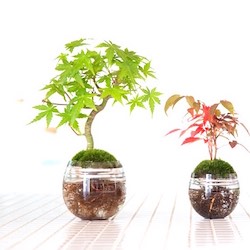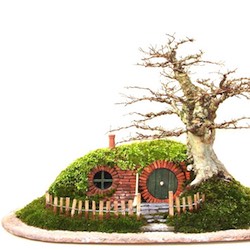Ornamental plant, or bonsai? Coconut bonsai have gained in popularity recently (especially in Indonesia) so we decided it was time to share some photos and information on our blog.
The coconut tree (Cocos nucifera) is a member of the palm tree family (Arecaceae), and grows in tropical regions like Indonesia and the Philippines. A fully grown Coconut can get up to 100ft (30m) tall with leaves of over 14ft (4m) long. Some dwarf varieties have been cultivated over time. Its root system is different from most trees (it does not grow a tap root, but a fibrous root system).
Keeping a coconut tree in a container can be a challenge, and keeping it small even more so. The tree does not grow branches and its trunk does not have cambium layers. But by restricting root growth and pruning leaves, the coconut can be kept small, which is why growers would refer to these as Coco Bonsai.

Coconut Bonsai trees.
Specific care guidelines for Coco Bonsai
Placement: The coconut tree will only grow well in tropical regions and need a high humidity for optimal growth (at least 75%). Ideally, temperatures are above 85°F (30 °C) in summer, with minimal temperatures in winter always above freezing. The coconut needs a sunny spot, with at least half a day direct sun light.
Watering: The coconut bonsai needs plenty water and should never dry out.
Fertilizing: The coconut should be fertilized quite strongly throughout the entire year. An organic, solid fertilizer is preferred but liquid fertilizer can also be applied.
Pruning and wiring: The coconut does not grow new branches, so pruning is restricted to the leaves. You can control growth by reducing the size of the leaves throughout the year. Wiring is not applied to coco bonsai.
Repotting: Repot the tree yearly using a well draining soil mixture. The soil should be able to store a bit of water, because the coconut bonsai does not like to dry out in between watering.
Propagation: Coconut bonsai can only be grown from seeds (cocunuts). Try to collect the coconuts from a healthy, fully grown coconut tree. The fruits should be completely intact, about a year old and when shaken you should hear water. To grow a coconut, plant them about halfway into soil with the pointed side down. To speed up the process of germination you can use a polybag with some drainage holes. Once the shoot is about a feet (30cm) tall (usually in 3-5 months time), you can remove the fibrous outside of the coconut to make it smaller and more attractive, and plant it in a bonsai pot.
Pests and diseases: Keep a close eye on the foliage of your coconut, if you see any pest identify it and use an organic pesticide if needed.
For more detailed information on these techniques, try our Bonsai tree care section. Photo credit by CocoBonsai and Andries.

Coconut tree with a well developed trunk.

Collection of coco Bonsai trees.




